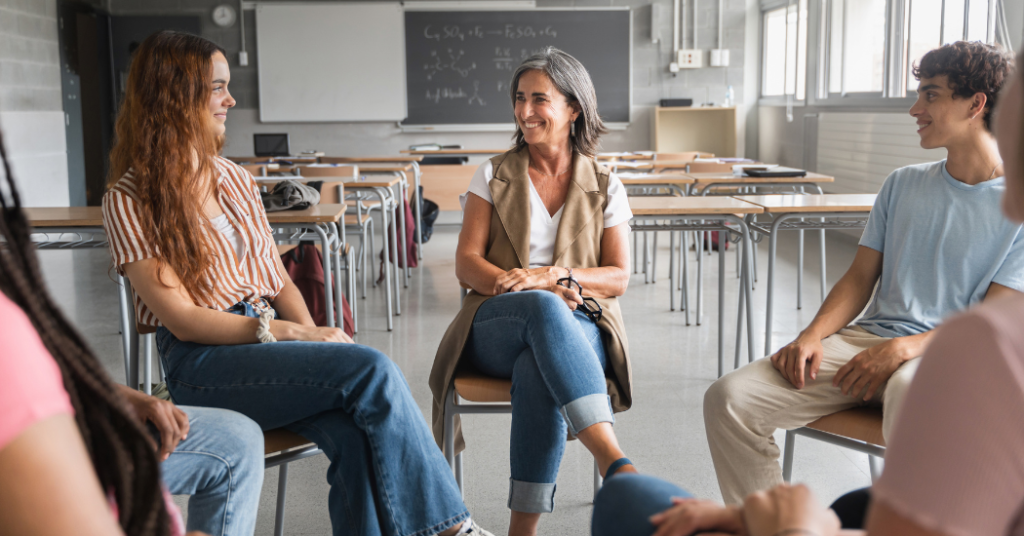On the Frontlines: Supporting Educators in Navigating the Student Mental Health Crisis

Illuminated by COVID’s unwelcome 2019 arrival, the term adolescent mental health crisis has continued to sift through the stratosphere, rising with increasing urgency to the apex of our societal discourse over the last twelve months.
Look, for one, at The Anxious Generation’s notable 25-week-run on the New York Times Bestseller list since its release last March. Jonathan Haidt’s text distills the brass tacks of this crisis into one cohesive dialogue, arguing parents have a responsibility to band together and begin the laborious—but doable—process of un-“rewiring” their children’s brains. While attending an intimate talk of Haidt’s last Spring, I was moved by his message. But, as I looked upon the hundreds of worried parents in the audience, I couldn’t help but consider the other portion of the population sculpting tomorrow’s children: educators.
Classroom teachers especially have consistently been on the front lines, guiding students through significant cultural crises. During that Haidt-hosted Zoom this past June, valuable nuggets of feedback were doled out to concerned parents in the audience. As, perhaps, one of the only non-parents there, I found myself in search of a different form of guidance. What—as teachers—do we do?
First, we need to better understand the current mental health climate and how this widespread challenge is affecting young people. Rather than relying solely on counselors and psychologists with insurmountable caseloads, we must come together as a school community, pool our resources, and have direct, open conversations with students about what mental health looks, feels, and sounds like for them.
Given the sensitivity and urgency of the mental health crisis, how can we, as educators, rise to meet this challenge? How do we equip ourselves with strategies, curricular guidelines, and pedagogical approaches to support students in recognizing their stressors, coping mechanisms, and overall social wellness?
I believe we start by approaching these themes—the brain, our nervous system, grief, our pervasive addiction to social media, and so on—with our most sturdy and informed professional hats on. The same hats that have allowed us to help students make sense of countless other fragile realities in years past—everything from the origins of the Black Lives Matter movement to the inner workings of Pythagorean Theorem. We approach this content with intentionality, resources, and time.
Ah, but time! If, according to Haidt, Generation Alpha is anxious, surely an apt descriptor for teachers everywhere is overworked. Adding one more thing to a teacher’s plate feels not only untenable but, in certain ways, unfair. Between thirty person rosters, six-course schedules, limited minutes in a day, stacks of papers to assess–asking educators to carve out time to prioritize something as seemingly opaque as mental health is a tall order. After all, those test scores won’t raise themselves!
If institutions want to genuinely educate and foster a sense of self in their children on a holistic level, it is time they begin to prioritize serving the mental health needs of their students in an explicit and overarching manner.
In that vein, I invite you to join me on October 21st for a day-long-intensive, dedicated to discussing how we, as educators, come together to support this facet of our students–and our–reality. Hosted at Crossroads Schools for Arts and Sciences in Santa Monica, this workshop explores the nuance of student mental health and provides attendees with the tools and language to begin framing this conversation in their classroom and school community as a whole. I hope to see you there!

Natalie Babcock is a veteran educator and Evergreen Certified Youth Mental Health Specialist. After cutting her teeth in the Early Childhood sector, Natalie earned her Masters Degree and Teaching Credential from Bay Area Teacher Training Institute (BATTI), in Oakland, California. In 2018, Natalie moved back home to her native Los Angeles and worked in LAUSD, before transitioning back to the Independent School sector. Most recently, she’s begun spearheading the development of Balancing Acts, a culturally-responsive mental health education program for early adolescent learners.
